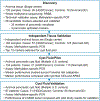Novel Methylated DNA Markers Discriminate Advanced Neoplasia in Pancreatic Cysts: Marker Discovery, Tissue Validation, and Cyst Fluid Testing
- PMID: 31306149
- PMCID: PMC7294458
- DOI: 10.14309/ajg.0000000000000284
Novel Methylated DNA Markers Discriminate Advanced Neoplasia in Pancreatic Cysts: Marker Discovery, Tissue Validation, and Cyst Fluid Testing
Abstract
Objectives: Pancreatic cystic lesions (PCLs) may be precancerous. Those likely to harbor high-grade dysplasia (HGD) or pancreatic cancer (PC) are targets for surgical resection. Current algorithms to predict advanced neoplasia (HGD/PC) in PCLs lack diagnostic accuracy. In pancreatic tissue and cyst fluid (CF) from PCLs, we sought to identify and validate novel methylated DNA markers (MDMs) that discriminate HGD/PC from low-grade dysplasia (LGD) or no dysplasia (ND).
Methods: From an unbiased whole-methylome discovery approach using predefined selection criteria followed by multistep validation on case (HGD or PC) and control (ND or LGD) tissues, we identified discriminant MDMs. Top candidate MDMs were then assayed by quantitative methylation-specific polymerase chain reaction on archival CF from surgically resected PCLs.
Results: Of 25 discriminant MDMs identified in tissue, 13 were selected for validation in 134 CF samples (21 cases [8 HGD, 13 PC], 113 controls [45 ND, 68 LGD]). A tree-based algorithm using 2 CF-MDMs (TBX15, BMP3) achieved sensitivity and specificity above 90%. Discrimination was significantly better by this CF-MDM panel than by mutant KRAS or carcinoembryonic antigen, with areas under the receiver operating characteristic curve of 0.93 (95% confidence interval: 0.86-0.99), 0.71 (0.57-0.85), and 0.72 (0.60-0.84), respectively. Cutoffs for the MDM panel applied to an independent CF validation set (31 cases, 56 controls) yielded similarly high discrimination, areas under the receiver operating characteristic curve = 0.86 (95% confidence interval: 0.77-0.94, P = 0.2).
Discussion: Novel MDMs discovered and validated in tissue accurately identify PCLs harboring HGD/PC. A panel of 2 MDMs assayed in CF yielded results with potential to enhance current risk prediction algorithms. Prospective studies are indicated to optimize and further evaluate CF-MDMs for clinical use.
Conflict of interest statement
CONFLICTS OF INTEREST
Figures






Similar articles
-
Methylated DNA in Pancreatic Juice Distinguishes Patients With Pancreatic Cancer From Controls.Clin Gastroenterol Hepatol. 2020 Mar;18(3):676-683.e3. doi: 10.1016/j.cgh.2019.07.017. Epub 2019 Jul 16. Clin Gastroenterol Hepatol. 2020. PMID: 31323382 Free PMC article.
-
American Gastroenterological Association guidelines are inaccurate in detecting pancreatic cysts with advanced neoplasia: a clinicopathologic study of 225 patients with supporting molecular data.Gastrointest Endosc. 2016 Jun;83(6):1107-1117.e2. doi: 10.1016/j.gie.2015.12.009. Epub 2015 Dec 18. Gastrointest Endosc. 2016. PMID: 26709110
-
Multimodal Pancreatic Cancer Detection Using Methylated DNA Biomarkers in Pancreatic Juice and Plasma CA 19-9: A Prospective Multicenter Study.Clin Gastroenterol Hepatol. 2025 Apr;23(5):766-775. doi: 10.1016/j.cgh.2024.07.048. Epub 2024 Oct 28. Clin Gastroenterol Hepatol. 2025. PMID: 39477082
-
Imaging modalities for characterising focal pancreatic lesions.Cochrane Database Syst Rev. 2017 Apr 17;4(4):CD010213. doi: 10.1002/14651858.CD010213.pub2. Cochrane Database Syst Rev. 2017. PMID: 28415140 Free PMC article.
-
Small cyst size and lack of growth as negative predictors of malignant transformation in low-risk intraductal papillary mucinous neoplasms of the pancreas: A systematic review and meta-analysis.United European Gastroenterol J. 2025 Feb;13(1):7-20. doi: 10.1002/ueg2.12666. Epub 2024 Oct 6. United European Gastroenterol J. 2025. PMID: 39370669 Free PMC article.
Cited by
-
High Detection Rates of Pancreatic Cancer Across Stages by Plasma Assay of Novel Methylated DNA Markers and CA19-9.Clin Cancer Res. 2021 May 1;27(9):2523-2532. doi: 10.1158/1078-0432.CCR-20-0235. Epub 2021 Feb 16. Clin Cancer Res. 2021. PMID: 33593879 Free PMC article.
-
Follow-Up Study Confirms the Presence of Gastric Cancer DNA Methylation Hallmarks in High-Risk Precursor Lesions.Cancers (Basel). 2021 Jun 2;13(11):2760. doi: 10.3390/cancers13112760. Cancers (Basel). 2021. PMID: 34199386 Free PMC article.
-
Application of EUS-based techniques in the evaluation of pancreatic cystic neoplasms.Endosc Ultrasound. 2021 Jul-Aug;10(4):230-240. doi: 10.4103/EUS-D-20-00216. Endosc Ultrasound. 2021. PMID: 34213426 Free PMC article. Review.
-
Biomarkers and Strategy to Detect Preinvasive and Early Pancreatic Cancer: State of the Field and the Impact of the EDRN.Cancer Epidemiol Biomarkers Prev. 2020 Dec;29(12):2513-2523. doi: 10.1158/1055-9965.EPI-20-0161. Epub 2020 Jun 12. Cancer Epidemiol Biomarkers Prev. 2020. PMID: 32532830 Free PMC article.
-
Tissue methylated DNA markers for sporadic pancreatic cancer are strongly associated with familial and genetically predisposed pancreatic cancer.Pancreatology. 2022 Sep;22(6):770-773. doi: 10.1016/j.pan.2022.06.259. Epub 2022 Jun 22. Pancreatology. 2022. PMID: 35843766 Free PMC article.
References
-
- Moris M, Bridges MD, Pooley RA, et al. Association between advances in high-resolution cross-section imaging technologies and increase in prevalence of pancreatic cysts from 2005 to 2014. Clin Gastroenterol Hepatol 2016;14:585–93.e3. - PubMed
-
- Lee KS, Sekhar A, Rofsky NM, et al. Prevalence of incidental pancreatic cysts in the adult population on MR imaging. Am J Gastroenterol 2010; 105:2079–84. - PubMed
-
- de Jong K, Nio CY, Hermans JJ, et al. High prevalence of pancreatic cysts detected by screening magnetic resonance imaging examinations. Clin Gastroenterol Hepatol 2010;8:806–11. - PubMed
-
- Scheiman JM, Hwang JH, Moayyedi P. American gastroenterological association technical review on the diagnosis and management of asymptomatic neoplastic pancreatic cysts. Gastroenterology 2015;148: 824–48.e22. - PubMed
-
- Tada M, Kawabe T, Arizumi M, et al. Pancreatic cancer in patients with pancreatic cystic lesions: A prospective study in 197 patients. Clin Gastroenterol Hepatol 2006;4:1265–70. - PubMed
MeSH terms
Substances
Grants and funding
LinkOut - more resources
Full Text Sources
Other Literature Sources
Medical
Miscellaneous

